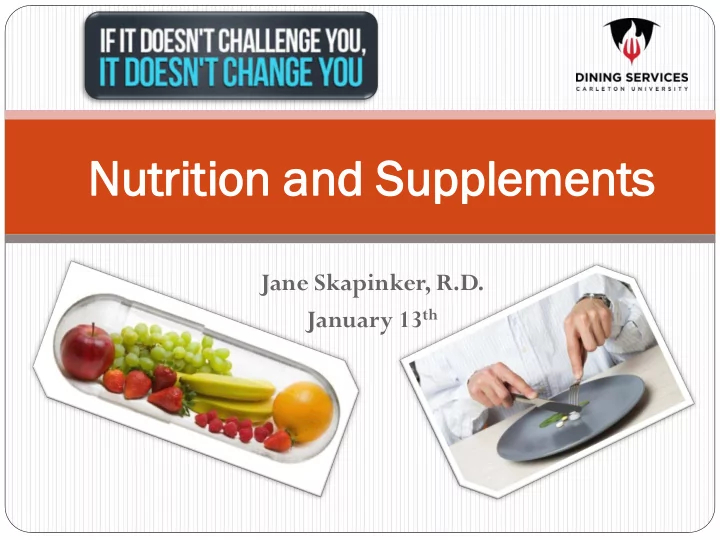

Nut utrition rition and nd Su Supplement lements s Jane Skapinker, R.D. January 13 th
Agen enda da Review challenge nutrition levels Hydration Supplements Probiotics Omegas Iron Calcium Vitamin D Goal Setting
Hy Hydr drat atio ion n Challenge rules: “Drink 1/3 of your bodyweight in ounces each day of water (20 ml per kg of bodyweight) to earn 1 point for this daily habit. Neither coffee nor alcoholic beverages count towards your water requirement, but non- caffeinated beverages do count.” 1 ounce = ~30mL
Di Dieta tary y Sup upplemen ements ts Includes vitamins, minerals, herbs, botanicals, enzymes, amino acids, and more. Available mostly without a prescription Please check with your doctor whether you need a supplement based on your current lifestyle, and medications To identify if a product has been authorized for sale in Canada look for the 8 digit NPN (Natural Product Number) or DIN-HM (Homeopathic Medicine Number)
Probiotics Bacteria that can help keep the natural balance of microflora in the intestine. Helps with digestion, bloating, IBS, constipation, diarrhea, etc. Lactobacillus and Bifidobacterium Prebiotics- non digestible carbohydates that act as “food”for the probiotics and helps them multiply (e.g. artichokes, bananas, onion)
Om Omeg egas as Omega-3 fats are a type of polyunsaturated fat known to benefit heart health. There are three main omega-3 fats found in foods: Alpha-linolenic acid (ALA) Vegetable oils (canola, soybean, flaxseed) Eicosapentaenoic acid (EPA) Docosahexaenoic acid (DHA) Both found in seafood, including fatty fish (salmon, tuna, trout) and shellfish (crab, mussels, oysters)
Omeg ega-3s s Sup upple lementa entati tion on Fish oil supplements contain doses ranging from 250mg to 2000mg Should I take a fish oil supplement? Canada's Food Guide recommends Canadians eat two 75 gram (or 2 ½ ounce) servings of fatty fish each week. A 75 gram serving is the size of a deck of cards. Two servings of fatty fish is equal to about 2000mg to 3000mg of omega-3 fat each week. Or, it is equal to 300 to 450mg per day
Om Omeg ega-3s 3s Sup upplem lementa entati tion on You may want to take a supplement if: Do not like to eat fish Are vegetarian or vegan Are at risk of heart disease Have heart disease Need to lower triglyceride levels Health Canada says that fish oil supplements are safe for adults at a dose of up to 3000mg per day .
Ir Iron on Iron is a mineral that is naturally present in food There are 2 types of iron “ heme” iron = comes from animal sources Found in: meat, fish, and poultry This type of iron is easily absorbed in the body “ non- heme” iron = comes from plant sources Found in: dried beans, peas, lentils, and some fruits and vegetables In Canada some grain products including flour, pasta, and breakfast cereals are fortified with iron Iron is better absorbed when taken with a source of Vitamin C (found in citrus fruits, cantaloupe, strawberry, broccoli, tomatoes, and peppers)
How w mu much h do o I nee eed (in mg mg)*? Age Male Female Pregnancy Lactation Birth- 6 months **0.27 **0.27 7-12 months 11 11 1-3 years 7 7 4-8 years 10 10 9-13 years 8 8 14-18 years 11 15 27 10 19-50 years 8 18 27 9 51+ years 8 8 Upper Up er Limit for iron is 45mg/da day y The RDS for vegeta etarian ans s is 1. 1.8 times s higher than for people e who eat meat *Recommended Daily Allowance (RDA) for Iron **For infants up to 6 months, the AI (adequate intake) established is based on the mean of iron intake of healthy, breastfed babies.
How will I know if I don’t get enough? Low iron levels can leave you tired, pale, and irritable Groups at risk for deficiency are: Young children, pregnant or pre-menopausal women, some athletes, vegetarians, and older adults Blood test results- Serum ferritin Serum Ferritin Level (ug/L) Probable diagnosis <15 Iron deficiency >15-50 Depletion of iron stores, probable iron deficiency >51-100 Reduced iron stores, possible iron deficiency
Common supplementation options • Iron tablets (Ferrous Fumarate)- 100 mg of elemental iron • Iron capsules (Ferrous Gluconate)- each capsule contains 35g of elemental iron • Liquid iron supplement- 1 tbsp per day • Iron injections- as recommended by MD
Steps to increase iron in your diet! Include one iron rich food and one vitamin C rich food at every meal Add cooked dried beans to soups, stews, or casseroles Choose breakfast cereal/flour that are fortified/enriches with iron- check labels! Choose dark green or orange vegetables more often e.g. spinach base for your salad Have pasta with tomato instead of cream sauce Have tea/coffee after meals because it can decrease iron absorption Add dried fruits to your muffin recipe or cereal
Cal alcium cium Calcium is an essential element for bone health The body ensures that it has a constant supply of calcium and does so in 3 ways: Absorbs it from our food It takes it from our bones when it’s lacking Reabsorbs calcium from the urine into the bloodstream
Vitam tamin in D: Key Factor in Calcium Absorption Vitamin D3 ↑ calcium absorption by as much as 30- 80%. Osteoporosis Canada recommends that Canadians aged 19-50, including pregnant or lactating women, receive at least 400 international units (IUs) of vitamin D3/day . Adults 50+ should receive at least 800 IUs . Most multivitamins provide 400 IUs of vitamin D3. Some calcium supplements also contain vitamin D
When you just can’t get enough Calcium Calculator The product label should state the amount of elemental calcium in each tablet, e.g., 500 mg of elemental calcium in each 1250 mg tablet of a brand of calcium carbonate supplement. The amount of elemental calcium is the figure you use to calculate your true daily intake. Products made from calcium carbonate are often recommended because they contain the highest %age of elemental calcium per mg of calcium source.
Recommend
More recommend